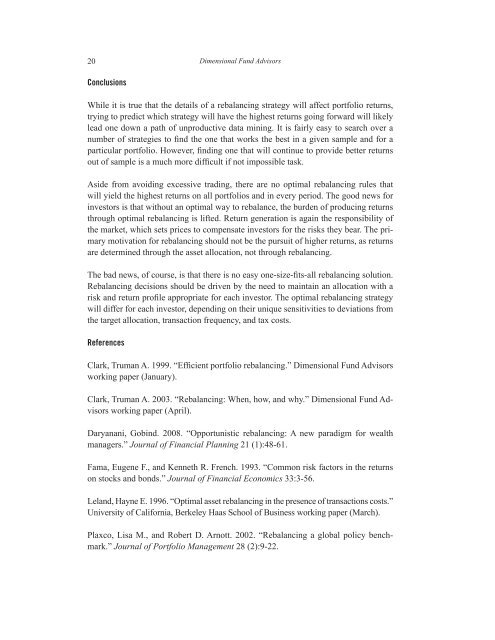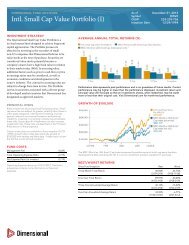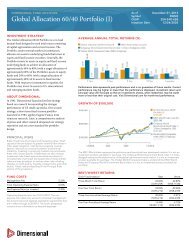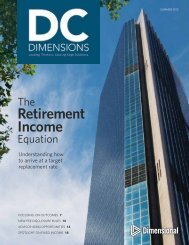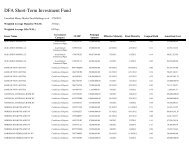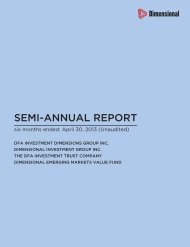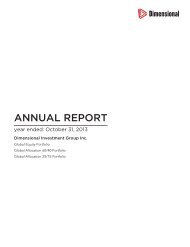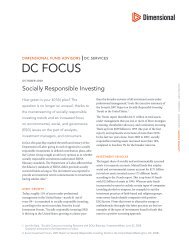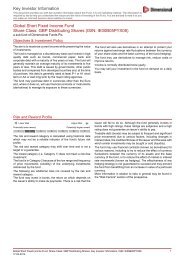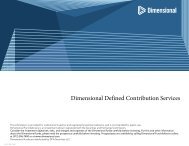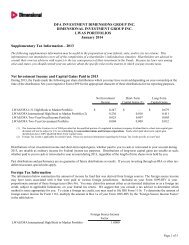Rebalancing and Returns.indd - Dimensional Fund Advisors
Rebalancing and Returns.indd - Dimensional Fund Advisors
Rebalancing and Returns.indd - Dimensional Fund Advisors
Create successful ePaper yourself
Turn your PDF publications into a flip-book with our unique Google optimized e-Paper software.
20<br />
<strong>Dimensional</strong> <strong>Fund</strong> <strong>Advisors</strong><br />
Conclusions<br />
While it is true that the details of a rebalancing strategy will affect portfolio returns,<br />
trying to predict which strategy will have the highest returns going forward will likely<br />
lead one down a path of unproductive data mining. It is fairly easy to search over a<br />
number of strategies to find the one that works the best in a given sample <strong>and</strong> for a<br />
particular portfolio. However, finding one that will continue to provide better returns<br />
out of sample is a much more difficult if not impossible task.<br />
Aside from avoiding excessive trading, there are no optimal rebalancing rules that<br />
will yield the highest returns on all portfolios <strong>and</strong> in every period. The good news for<br />
investors is that without an optimal way to rebalance, the burden of producing returns<br />
through optimal rebalancing is lifted. Return generation is again the responsibility of<br />
the market, which sets prices to compensate investors for the risks they bear. The primary<br />
motivation for rebalancing should not be the pursuit of higher returns, as returns<br />
are determined through the asset allocation, not through rebalancing.<br />
The bad news, of course, is that there is no easy one-size-fits-all rebalancing solution.<br />
<strong>Rebalancing</strong> decisions should be driven by the need to maintain an allocation with a<br />
risk <strong>and</strong> return profile appropriate for each investor. The optimal rebalancing strategy<br />
will differ for each investor, depending on their unique sensitivities to deviations from<br />
the target allocation, transaction frequency, <strong>and</strong> tax costs.<br />
References<br />
Clark, Truman A. 1999. “Efficient portfolio rebalancing.” <strong>Dimensional</strong> <strong>Fund</strong> <strong>Advisors</strong><br />
working paper (January).<br />
Clark, Truman A. 2003. “<strong>Rebalancing</strong>: When, how, <strong>and</strong> why.” <strong>Dimensional</strong> <strong>Fund</strong> <strong>Advisors</strong><br />
working paper (April).<br />
Daryanani, Gobind. 2008. “Opportunistic rebalancing: A new paradigm for wealth<br />
managers.” Journal of Financial Planning 21 (1):48-61.<br />
Fama, Eugene F., <strong>and</strong> Kenneth R. French. 1993. “Common risk factors in the returns<br />
on stocks <strong>and</strong> bonds.” Journal of Financial Economics 33:3-56.<br />
Lel<strong>and</strong>, Hayne E. 1996. “Optimal asset rebalancing in the presence of transactions costs.”<br />
University of California, Berkeley Haas School of Business working paper (March).<br />
Plaxco, Lisa M., <strong>and</strong> Robert D. Arnott. 2002. “<strong>Rebalancing</strong> a global policy benchmark.”<br />
Journal of Portfolio Management 28 (2):9-22.


